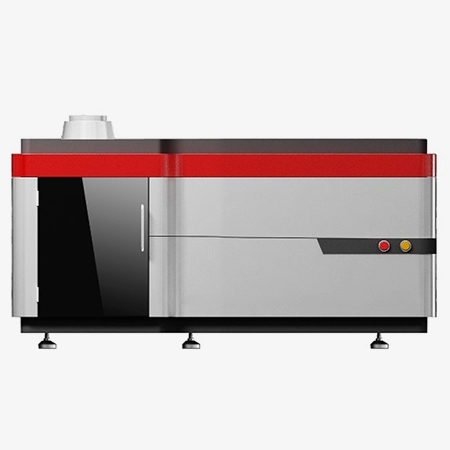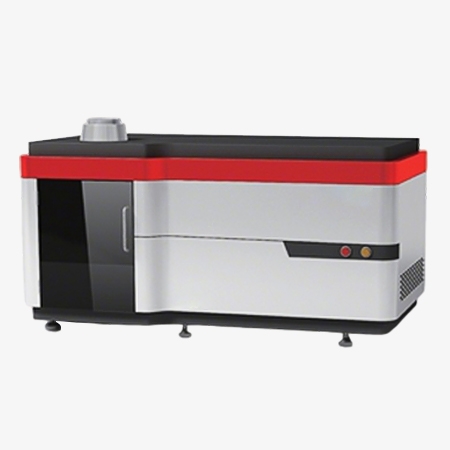The inductively coupled plasma optical emission spectrometer is used to determine the content of trace and trace elements in different substances (dissolved in nitric acid, hydrochloric acid, hydrofluoric acid). It is widely used in various fields such as environmental protection, petroleum products, rare earths, semiconductors, geology, metallurgy, chemical engineering, clinical medicine, food, biological samples, criminal science, agricultural research, etc.

Solid state RF power supply technology
- The inductively coupled plasma optical mass spectrometer features a large-sized CID detector with continuous coverage in the wavelength range of 165-900nm, with one exposure and full spectrum display.
- It also adopts fully automatic matching technology for load, with fast matching speed, improving the efficiency of power supply and instrument stability, and making the entire ignition process simple and convenient.

High precision constant temperature system
- The overall optical path is protected by a precision constant temperature system, and the temperature control can be set in real-time according to the actual ambient temperature of the customer's laboratory.
- The inductively coupled plasma optical mass spectrometer does not require continuous air conditioning for a long time, with a temperature control accuracy of ≤± 0.1 ℃. The precise constant temperature system ensures the stability of the optical path, and the test data is more stable.
Applications
The SISCO inductively coupled plasma optical emission spectrometer is a high-precision and high-sensitivity isotope measurement instrument widely used in fields such as earth science, environmental science, biomedicine, and the nuclear industry.
 Geology
Geology
 Metallurgy
Metallurgy
 Semiconductor
Semiconductor
 Chemical Industry
Chemical Industry
| Model | SISCO-IPCOMS-6810A2 | ||
| The Whole Machine Specs | |||
| Observation Method | Bidirectional observation | ||
| Liquid Content | 0.01 ppm~several thousand ppm | ||
| Solid Content | 0.001%~70% | ||
| Repeatability | The relative standard deviation (RSD) of short-term stability is less than 1% | ||
| Stability | Relative standard deviation RSD<1.5% @ 2 hours | ||
| Test Speed | The reading time for a single spectral line CID is only 2m/s, and all elements can be measured within one minute | ||
| Element Detection Limit(μg/L) | Most elements are 1ppb~10ppb | ||
| The RF Generator Specs | |||
| Output | 800~1500W | ||
| Frequency Stability | 0.05% | ||
| Output Power Stability | <0.01% | ||
| Electromagnetic Field Leakage Radiation Intensity | Electric field strength E at a distance of 30cm from the chassis: < 5V/m | ||
| The Injection Device Specs | |||
| Output Working Coil | Inner diameter 25mm, three turns | ||
| Three Concentric Quartz Rectangular Tubes | Outer diameter 20mm; there are multiple models to choose from based on the size of the central channel | ||
| Efficient Imported Atomizer | Concentric atomizer, outer diameter 6mm; multiple models available, high salt, HF resistant, etc | ||
| Atomization Chamber | Double tube atomization chamber, optional swirl atomization chamber, outer diameter 57.2mm | ||
| Peristaltic Pump | Twelve rotors and four channels, the speed can be adjusted according to the required flow rate (set according to the injection speed, intuitive and accurate) | ||
| Total Consumption of Argon Gas | The total consumption of argon gas is less than 14L/min | ||
| Argon Flowmeter and Carrier Gas Pressure Gauge Specs | |||
| Plasma Gas Flowmeter | (100-1000) L/h(1.6-16L/min) | ||
| Auxiliary Gas Flow Meter | (6-60) L/h(0.1-1L/min) | ||
| Carrier Gas Flowmeter | (6-60) L/h(0.1-1L/min) | ||
| The Spectrometer Specs | |||
| Wavelength Range | (165 nm~950 nm) | ||
| Focal Length | 430mm | ||
| Numerical Aperture | F/8, Ultra-high luminous flux ensures the detection limit and sensitivity of the instrument | ||
| Resolution | <0.0068nm@200nm | ||
| Stray | The equivalent background concentration of 10000ppmCa solution at As189.042nm is less than 2ppm | ||
| Light Room | Precise constant temperature, 35 ± 0.1℃ | ||
| Distributed Nitrogen Purging | Normal blowing 2L/min, rapid blowing 4L/min | ||
| The Detection Device Specs | |||
| Detector Type | CCD | ||
| Linear Dynamic Range | 108 | ||
| Wavelength Response Range | 165nm~1000nm | ||
| Quantum Efficiency | Without any coating, the 200nm ultraviolet region can reach over 35% | ||
| Detector Cooling | Advanced three-level semiconductor refrigeration, cooling temperature -45℃ | ||
Q1: What is ICP-OMS?
A1: ICP-OES (Inductively Coupled Plasma Optical Emission Spectrometer) is an analytical instrument used to detect the concentrations of metal and non-metal elements in samples. It uses high-temperature plasma to excite atoms in the sample, causing them to emit light of specific wavelengths, and then determines the content of each element through spectral analysis.
Q2: What is the difference between ICP-OES and AAS (Atomic Absorption Spectroscopy)?
A2: ICP-OES: It can simultaneously detect multiple elements, with fast speed and high sensitivity. AAS: Generally, only one element can be detected at a time, and the operation is slow, suitable for analyzing a small number of samples. ICP-OES is more suitable for complex samples and multi-element analysis.
Q3: What is the detection limit of ICP-OES?
A3: The detection limit is usually in the range of ppb (parts per billion) to ppm (parts per million) for different elements and sample matrices. For example, the detection limit for sodium (Na) can reach 1 ppb.
Tips: What are the daily maintenance procedures for ICP-OES?
- Regularly replace the peristaltic pump tube
- Clean the injection system and atomizer
- Calibrate wavelength and intensity
- Check if the argon gas supply is normal
- Clean the optical system (depending on the pollution situation)
Thank you for buying industrial test and measurement equipment on SISCO.com, all products sold by SISCO and the partner cover a 12 months warranty, effective from the date of receiving the products.
What is covered?
SISCO is responsible for providing free spare parts, and free technical support to assist the customer to repair the defective products until the problem is solved.
What is not covered?
- Product purchased from anyone other than a SISCO store or a SISCO authorized reseller.
- Expendable parts.
- Routine cleaning or normal cosmetic and mechanical wear.
- Damage from misuse, abuse or neglect.
- Damage from use of parts other than SISCO approved.
- Damage from use outside the product’s usage or storage parameters.
- Damage from use of parts not sold by SISCO.
- Damage from modification or incorporation into other products.
- Damage from repair or replacement of warranted parts by a service provider other than a SISCO authorized service provider.
- Damage caused by the application environment not meeting the product usage requirements and the failure to perform preventive maintenance.

